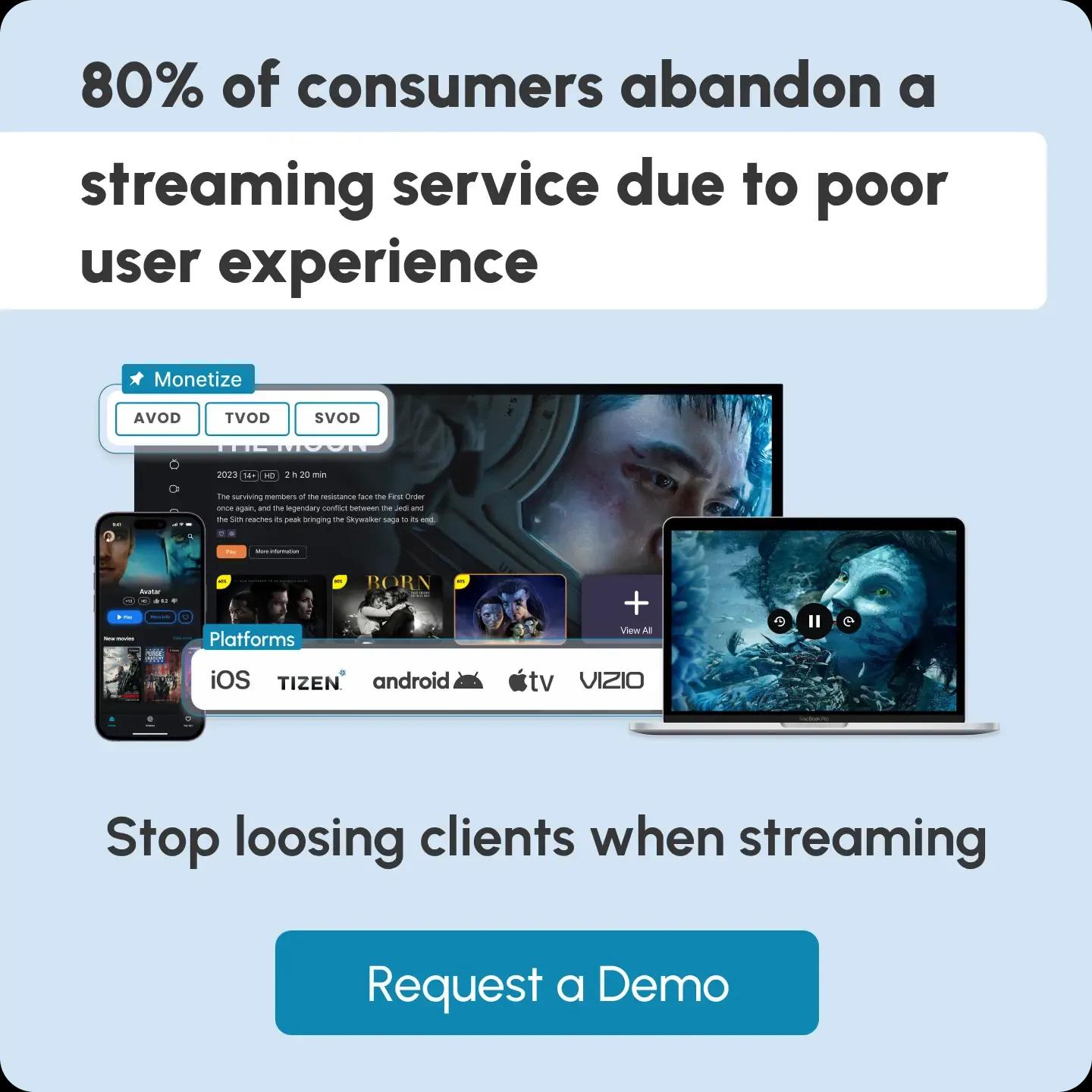
OTT Business Models: A Complete Guide
OTT platforms like Netflix, Disney+, and Hulu have redefined convenience, offering viewers endless variety, instant access, and personalized experiences. It’s no wonder this industry has exploded in popularity—and your platform can be part of that success story.
But here’s the key: Your OTT revenue model matters.
Whether you’re leaning toward subscriptions, ad revenue, pay-per-view, or a hybrid approach, success depends on aligning your strategy with your audience’s needs and your revenue goals.
In this guide, we’ll unpack the most effective OTT business models, explore their advantages, and help you figure out which one is the perfect fit for your platform.

Understanding OTT Business Models
OTT services offer flexibility and accessibility for viewers. For streaming businesses and content creators, an OTT platform provides exciting opportunities to generate revenue, engage audiences, and scale operations globally.
But what is an OTT business model, and how do streaming services make money?
At its core, an OTT business model refers to how an over-the-top platform delivers content to viewers to generate income. That’s why the right monetization method can make all the difference.
OTT business models aren’t one-size-fits-all—they’re designed to fit different types of content and cater to diverse viewer preferences. Whether you’re streaming movies, live sports, or educational tutorials, an effective OTT business plan ensures your platform scales effortlessly while staying flexible enough to adapt to changing audience demands.
Types of OTT Content
First, let’s understand the diverse range of content types that appeal to audiences. Here’s a breakdown of the most popular categories and why they matter:
1. Video Content
On-demand videos, TV series, movies, and live streaming dominate most OTT platforms. This category is a crowd favorite because it caters to a broad range of entertainment needs, from binge-worthy series to exclusive live events. Video content is often the main reason consumers flock to a platform, making it a cornerstone of any OTT business strategy.
2. Audio Content
Podcasts, audiobooks, and music streaming services make up a significant share of the OTT market. Audio content is perfect for leisure and multitasking, appealing to those who want an immersive experience without being tied to a screen. It’s a go-to choice for audiences seeking entertainment, education, or relaxation.
3. e-Learning Content
Webinars, tutorials, and online courses are on the rise as more people embrace remote learning. This type of content attracts students and professionals looking to gain new skills or deepen their knowledge at their convenience. Platforms offering educational content tap into a dedicated and growing market.
4. Gaming Content
Gaming content, including live streams, esports competitions, and tutorials, is booming among tech-savvy consumers. Gamers flock to OTT platforms to watch live gaming sessions, engage with esports events, or improve their skills through instructional videos. This category fosters strong community engagement and offers high growth potential.
5. Real-Time News and Updates
For viewers seeking immediate, reliable information, real-time news remains essential. This includes live sports coverage, breaking news, and weather updates. OTT platforms offering up-to-date information keep audiences connected and engaged with the world around them.
Ready to build a platform that caters to everyone? Start crafting your OTT platform with inoRain and monetize your content with 5+ monetization methods.
Types of OTT Business Models
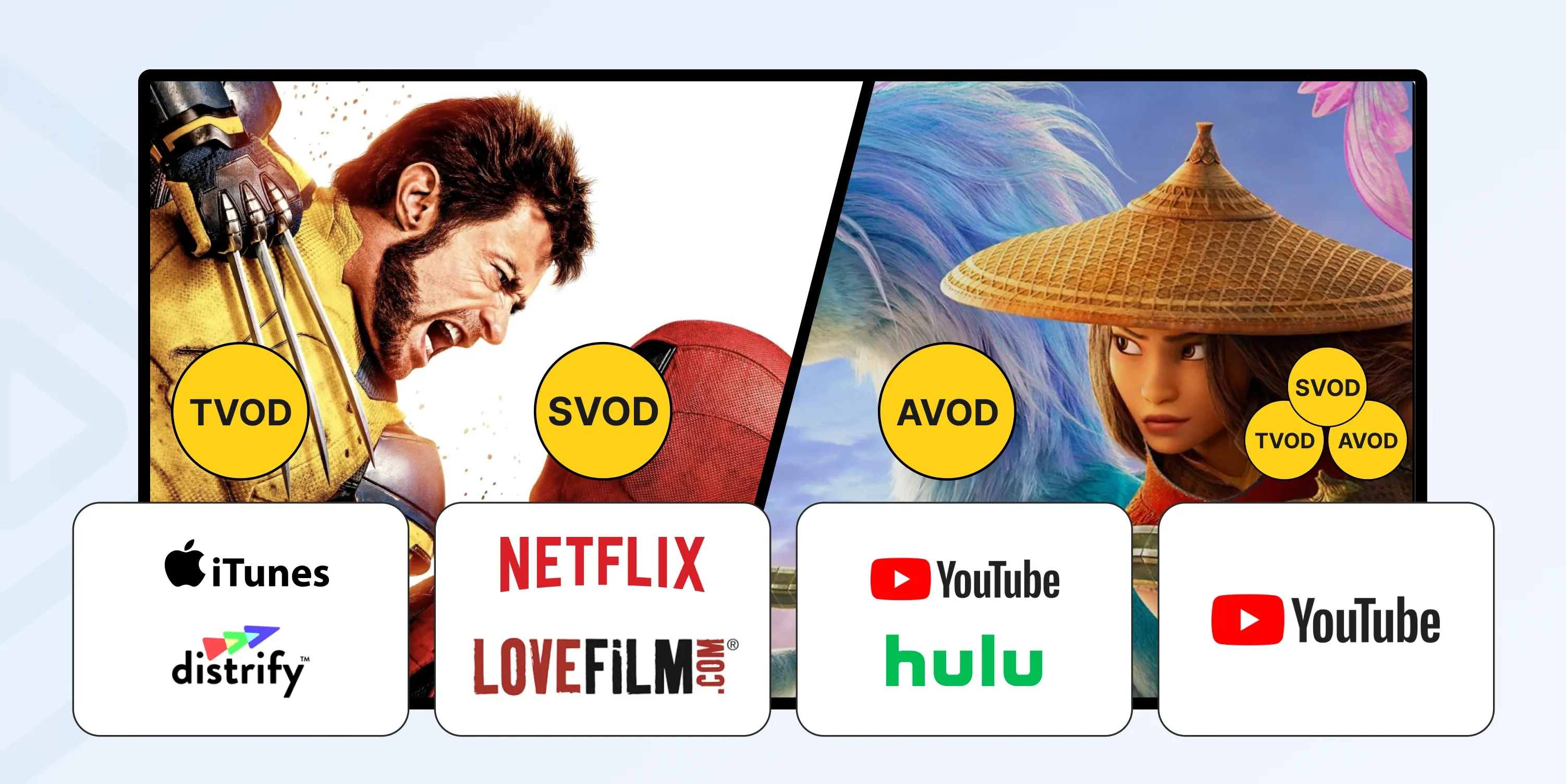
To build a profitable platform, you must choose an OTT business model that caters to your specific revenue goals and audience preferences.
Here are four popular options:
Subscription Video on Demand (SVOD)
With SVOD, users pay a regular fee—monthly or annually—for unlimited access to a library of content. Platforms like Netflix and Disney+ thrive on this model by offering exclusive and engaging content to retain subscribers. This approach is perfect for businesses aiming for steady revenue and long-term customer loyalty.
Advertising Video on Demand (AVOD)
AVOD provides free access to content, supported by ad revenue. Platforms like YouTube rely heavily on ad placements for income. This OTT monetization model works well for reaching large audiences and generating revenue through high viewership.
Transactional Video on Demand (TVOD)
TVOD allows users to pay per piece of content, such as renting or buying a movie or accessing an online event. Platforms like Google Play and iTunes use this model, which is ideal for premium or exclusive content. It appeals to consumers who value flexibility and are willing to pay for specific items.
Hybrid Model
The hybrid model combines elements of SVOD, AVOD, and TVOD, appealing to diverse audience needs. For example, Hulu offers subscription tiers, including ad-free options. This versatile approach maximizes revenue by providing flexible pricing and content access that suits different user preferences and demographics.
Choosing the Right OTT Business Model for Your Platform
To choose the best OTT business model, consider your target audience, the kind of content you offer, and your long-term goals.
Choose SVOD for Premium Content
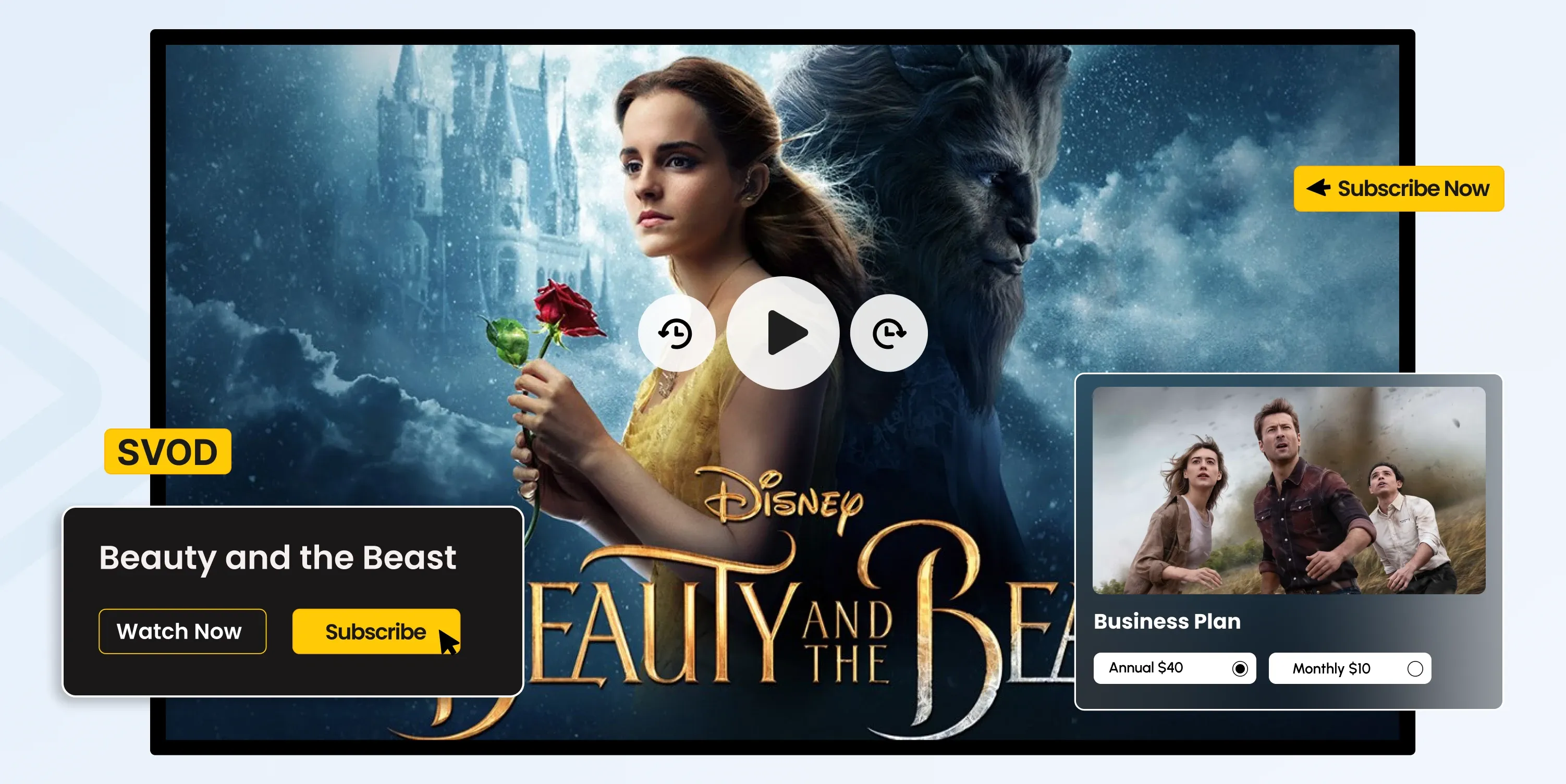
SVOD
If your platform primarily offers premium TV series or movies, the SVOD model might be your best bet. This approach motivates customers to pay a steady subscription fee, therefore guaranteeing a constant income stream while fostering subscriber loyalty.SVOD is all about delivering consistent value to subscribers.
SVOD Quick Tips
- Invest in original, high-quality productions that keep viewers engaged and returning.
- Use personalized recommendations and offer periodic discounts or loyalty perks to reduce churn.
- Localize content to attract international subscribers and tap into broader markets.
Use AVOD to Expand Your Reach

AVOD
Looking to reach a wide audience while keeping your content free? The AVOD model is an excellent choice. Revenue comes from ad placements, making it ideal for platforms like YouTube that balance accessibility with monetization. This OTT streaming business model works best if your goal is to attract a large viewership and profit through high ad impressions.
AVOD Quick Tips
- Work with advertisers targeting specific demographics to increase CPM (cost per mille) rates.
- Focus on shorter, engaging videos that pair well with non-intrusive ads.
- Offer rewards, like ad-free viewing, for completing surveys or engaging with advertisers.
Consider TVOD for Exclusive Content
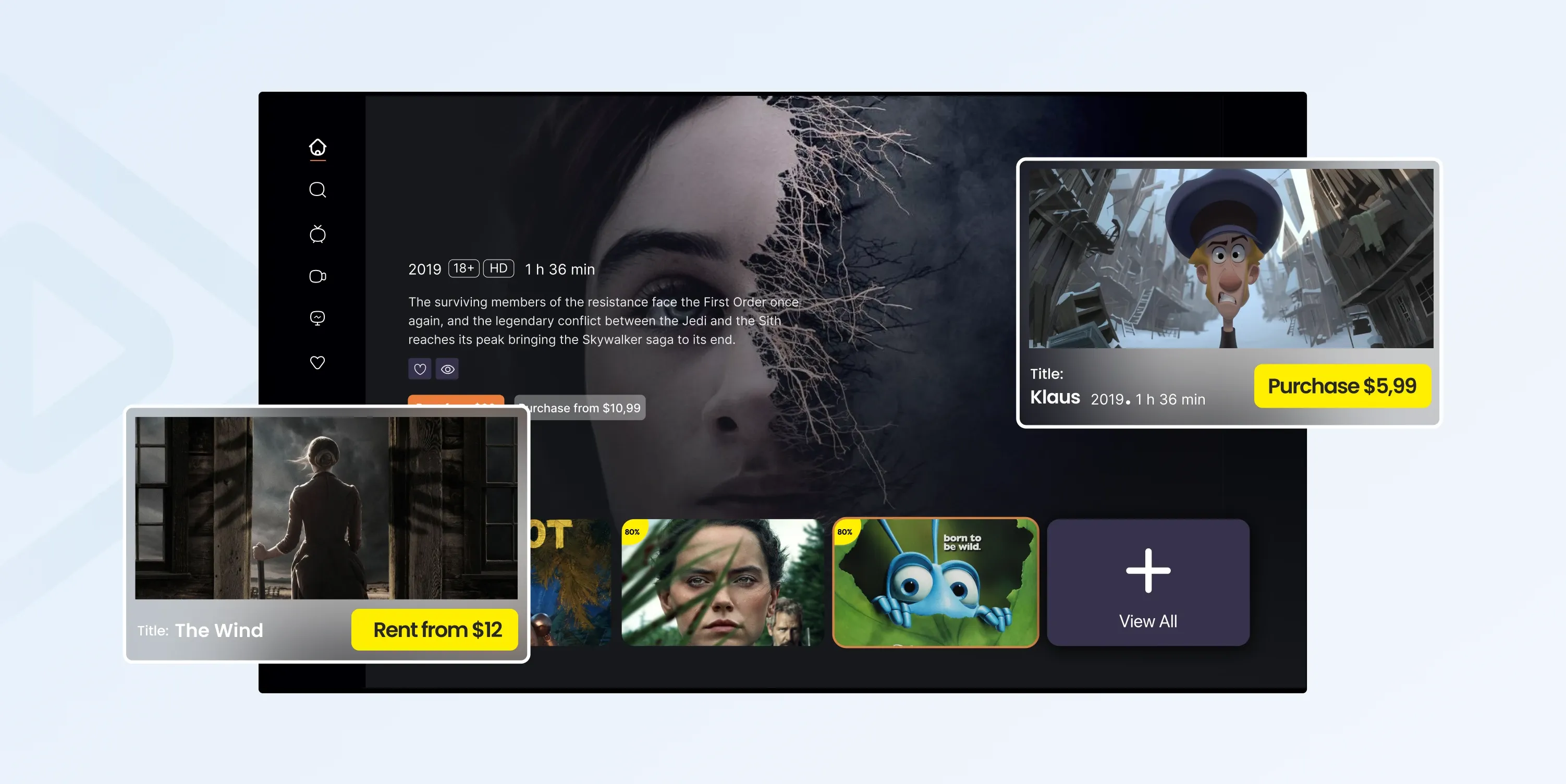
TVOD
For platforms offering exclusive content, the TVOD can maximize income. By allowing users to purchase or rent individual titles, such as blockbuster movies or limited-time events, you can cater to customers who seek flexibility and are willing to pay a premium for specific experiences.
TVOD Quick Tips
- Highlight blockbuster releases, live events, or unique content that warrants a one-time purchase.
- Adjust prices based on demand or timing, such as early access pricing or discounts for late renters.
- Use limited-time offers or bundled deals to encourage more purchases.
Opt for a Hybrid Model for Multiple Revenue Streams
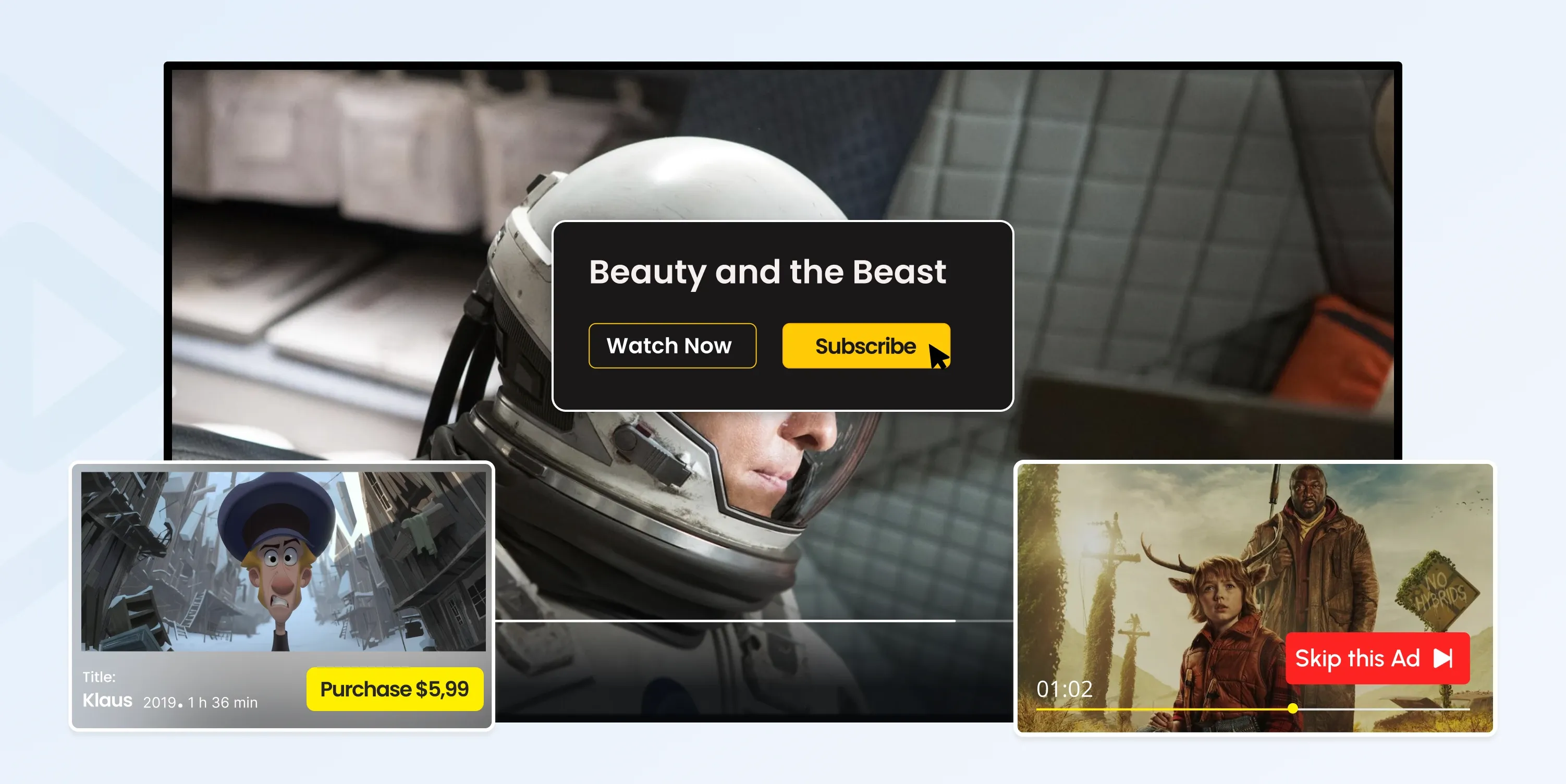
HVOD
The hybrid approach combines elements of SVOD, AVOD, and TVOD, offering options for diverse audience preferences. It’s an ideal OTT business model that caters to the varying needs of a broader target market.
Hybrid Model Quick Tips
- Offer different plans, such as ad-supported, ad-free, or premium tiers, to appeal to various users.
- Balance free, subscription, and pay-per-view content to maximize revenue streams.
- Use data to track user behavior and refine the mix of monetization methods based on performance.
Revenue Streams in OTT Business Models
Here are the primary revenue streams across different OTT business models:
| Revenue Stream | How it Works | Key Advantages | Examples |
|---|---|---|---|
| Subscriptions (SVOD) | Users pay a recurring fee (monthly or annually) for unlimited content access. | Steady income promotes customer retention. | Netflix, Disney+ |
| Advertising Revenue (AVOD) | Advertisers pay for ad placements in or around free content. | Large audience reach, no paywalls, potential for high ad impressions. | YouTube, Pluto TV |
| Pay-Per-View (TVOD) | Users pay to rent or purchase specific titles, like movies or events. | High revenue per transaction, ideal for premium content. | iTunes, Google Play Movies |
| Hybrid Models | Combines SVOD, AVOD, and TVOD elements with tiered pricing. | Appeals to diverse users, maximizes revenue streams. | Hulu, Amazon Prime Video |
| Sponsored Content | Brands pay for exclusive shows, co-branded events, or product placement within content. | Diversifies revenue, enhances content libraries. | Brand collaborations on OTT apps |
| Data Monetization | Platforms sell anonymized user data or use it for targeted advertising and content improvement. | Increases ad revenue, supports personalized experiences. | Ad targeting on streaming services |
Metrics and KPIs for Each OTT Business Model
Monitoring the right metrics and KPIs is vital to the success of your OTT business plan. Each OTT strategy relies on specific metrics to measure audience involvement and platform performance. Here’s a breakdown of the essential KPIs for various OTT business models:
SVOD Metrics
- Churn Rate: Calculates, over a specified period, the proportion of consumers cancelling their subscriptions. Reduced turnover points to strong consumer loyalty and satisfaction.
- Customer Lifetime Value (CLV): Determines the income a user of your OTT platform is projected to bring in. This clarifies the long-term worth of your audience.
- Monthly Recurring Revenue (MRR): Tracks monthly subscription income, enabling monthly income and growth trend forecasts to help refine your OTT video monetization tactics.
- Retention Rate: Reflects the success of your content and user experience by indicating the proportion of members who continue to subscribe to your OTT service.
Metrics for Ad-Based Models (AVOD)
- Ad Impressions: Counts the times adverts are shown to consumers to get an understanding of their reach and impact.
- Click-Through Rates (CTR): Measures ad engagement levels by tracking the proportion of users clicking on ads after viewing them.
- Cost Per Mille (CPM): Calculates the cost advertisers pay for every 1,000 ad views, which enables income analyses as part of your OTT business strategy.
- Watch Time: Track users' overall viewing time to directly influence the possibility for ad income.
Metrics for Pay-Per-View Models (TVOD)
- Pay-Per-View Revenue: Tracks user income from renting or buying particular content items.
- Conversion Rates: Calculates the proportion of consumers who buy content after browsing, therefore highlighting the value of your content library and pricing.
- Average Transaction Value (ATV): Shows the typical transaction amount spent on average over a specified period, so revealing consumer behavior relevant to this OTT revenue model.
- Content Popularity: Analyzes which content titles result in the most transactions, offering valuable insights to inform content distribution strategies.
Metrics for Hybrid Models
- ARPU (Average Revenue Per User): Combines sales, advertisements, and subscription income to calculate the average income potential of each user.
- Engagement Metrics: Tracks user behavior at several levels—watch time and interactivity, for example—to evaluate the hybrid model's success.
- Customer Segmentation Data: Shows user activity across free, ad-supported, and premium levels, therefore allowing upselling and focused marketing.
- Revenue Split Analysis: Calculates the percentage of income coming from ads, transactions, and subscriptions, respectively, to help inform your OTT business strategy.
5 Challenges in Implementing OTT Business Models
Successfully implementing an OTT business model requires overcoming a range of challenges that demand careful planning, adaptability, and strategic execution. Here are some of the most common obstacles (and how to overcome them):
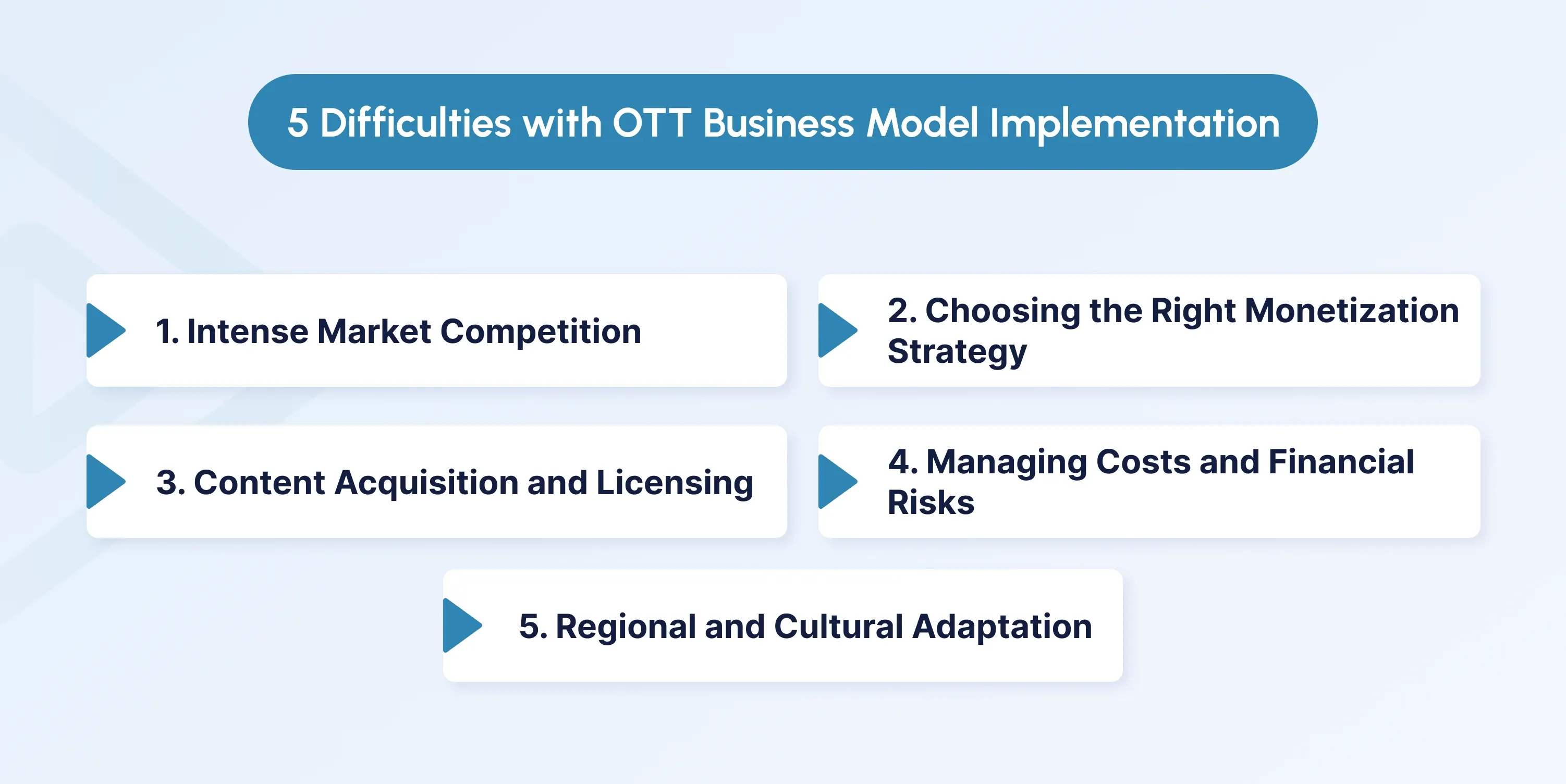
1. Intense Market Competition
Standing out in a crowded OTT landscape is tough, with many platforms offering similar services.
Solution: Invest in exclusive content, advanced technologies, and personalized user experiences to differentiate your OTT platform and build a strong value proposition.
2. Choosing the Right Monetization Strategy
Misaligned business models can lead to low retention, declining revenue, or operational challenges.
Solution: Regularly assess market trends and audience behavior to fine-tune your OTT monetization strategy. Consider hybrid models to cater to diverse user needs.
3. Content Acquisition and Licensing
Obtaining high-quality, diverse content is costly and competitive.
Solution: Focus on building partnerships for licensing deals and explore creating original, niche content to reduce dependency on external providers.
4. Managing Costs and Financial Risks
High production, licensing, and operational costs can threaten profitability.
Solution: Implement robust financial planning, monitor ROI on content investments, and explore cost-effective production strategies like co-productions.
5. Regional and Cultural Adaptation
Failure to cater to local tastes and preferences can limit your audience reach.
Solution: Localize content with translations and cultural adjustments. Produce region-specific content to resonate with target demographics.
OTT Business Models with inoRain

inoRain provides tailored OTT solutions to help you successfully implement and scale diverse OTT business models. Whether your platform operates on a subscription-based, ad-supported, or hybrid model, inoRain equips you with the tools and technology to achieve your goals.
We provide you with:
- Scalable Video Monetization
- Improved User Experiences
- Advanced Analytics for Smarter Decisions
- Top-Tier Security and Compliance with Multi-DRM Protection
With our white-label OTT platform, you can navigate challenges, deliver exceptional value to your audience, and maximize your income potential.
Contact us to learn more.
Conclusion
The success of your OTT platform depends on selecting the right OTT business model and strategy. By understanding the various revenue models, income streams, and KPIs, you can create a scalable, profitable service tailored to your audience’s needs.
While challenges like competition and content acquisition exist, partnering with a reliable platform like inoRain will simplify the journey. With robust tools and expert support, inoRain empowers you to overcome obstacles, refine your approach, and scale your platform with confidence.
Frequently Asked Questions
Founder / CEO
Andranik is the CEO and Co-Founder of inoRain OTT and the Co-Founder of HotelSmarters, specializing in next-generation streaming technologies and digital transformation for the hospitality sector. He focuses on building innovative, scalable solutions for video delivery, OTT monetization, and data-driven hospitality management. His work bridges technical sophistication with practical business impact, helping organizations modernize their digital ecosystems and improve operational efficiency.

OTT Advertising: Types, Best Practices, and Strategies
Over-the-top (OTT) advertising has transformed how brands connect with consumers.

VPlayed Alternatives: inoRain vs. VPlayed
Explore inoRain as a VPlayed alternative, comparing features, pricing, and OTT solutions to find the best platform for your streaming needs.

Custom OTT Platform Development: How to Start an OTT Business
This guide will walk you through everything you need to know about the OTT platform development.
